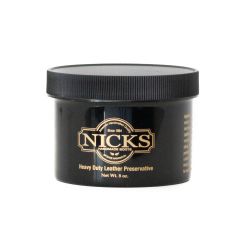How To Darken Leather

Key Takeaways:
- Proper Testing is Crucial: Before fully darkening leather items, it’s vital to test the darkening agent on a small, inconspicuous area to ensure compatibility and desired color depth. This helps avoid unexpected outcomes and potential damage to the leather.
- Use of Specific Products: Different types of leather require specific darkening products; using the wrong type can lead to damage. Full-grain leather benefits from oils that enhance its patina, while top-grain and suede might require specific dyes to maintain their structure and appearance.
- Regular Maintenance Enhances Durability: After darkening, regular maintenance including cleaning and conditioning is essential. This not only preserves the new color but also extends the life of the leather, ensuring it remains vibrant and supple over time.
At Nicks Boots, we take pride in creating high-quality leather boots and equipping our customers with the knowledge needed to keep and improve their valuable purchases. As specialists in leather care, we are here to walk you through the process of darkening leather—a sought-after technique to personalize or rejuvenate your boots.
This piece will discuss different methods to effectively darken leather, the crucial materials required, and expert advice to make sure your boots maintain their optimal appearance for years. Join us as we explore this detailed process and uncover the secrets to keeping the deep, dark hues of your leather boots.


Understanding Leather Types
Identifying Your Leather Type
To select the appropriate darkening technique, it's essential to identify your leather type accurately. Full-grain leather will display natural marks and have a robust feel, indicating its premium quality. Top-grain leather, smoother and more uniform, is slightly less durable but still high quality. Suede, distinctly different, feels soft and velvety, requiring a different approach altogether.
Darkening Full-Grain Leather
Darkening full-grain leather enhances its natural features and durability. Begin by cleaning the surface with a dedicated leather cleaner to remove dirt and grime. Apply a leather darkening oil using a soft cloth, rubbing in a circular motion; this allows the oil to penetrate deeply. Gradually build the color with multiple thin coats, letting each layer absorb fully before adding the next.
Darkening Top-Grain Leather
Top-grain leather, being finer and less dense, needs careful darkening to avoid damage. Apply a specific top-grain leather dye in thin, even layers, checking the saturation with each application. Start with a small, inconspicuous area to ensure the color matches your expectations. Let each layer dry completely, which helps prevent the leather from becoming overly stiff or dark.
Darkening Suede
Suede is particularly sensitive due to its textured surface. Use a spray or brush to apply a suede-specific dye, ensuring light, even coverage to maintain the material’s softness. After applying the dye, brush the suede gently with a suede brush to restore and even out the nap, which can become matted during the dyeing process. This method helps avoid patchiness and preserves the unique texture of suede.
Materials Needed For Leather Darkening
- Leather Cleaner - Start with a quality leather cleaner to ensure that your boots are free from dirt and oils, which can affect the absorption and evenness of the darkening agent. This step is crucial for preparing the leather to receive the darkening treatment effectively.
- Darkening Agent: Oil or Dye - Select the appropriate darkening agent based on your leather type. Oils work well for full-grain leather, enhancing its natural patina, while dyes are better for top-grain and suede to achieve a more uniform color change.
- Application Tools: Cloths and Sponges - Soft cloths or sponges are necessary for applying the darkening agent. These tools help in evenly distributing the oil or dye over the leather surface, minimizing streaks and blotches.
- Protective Gear: Gloves - Wearing gloves protects your hands from stains and the chemicals in leather dyes and oils. This is an essential safety measure to prevent skin irritation during the darkening process.
- Optional: Leather Conditioner - After darkening, applying a leather conditioner can help maintain the leather's elasticity and luster. This step is optional but recommended to extend the life and appearance of your darkened boots.
Step-By-Step Guide To Darkening Leather
Step 1: Clean The Leather
Start by using a high-quality leather cleaner to thoroughly clean the leather surface of your boots. This step is essential to remove all surface oils and contaminants that could hinder the absorption of the darkening agent. Allow the boots to air dry completely in a cool, dry place, avoiding direct sunlight or heat sources to prevent any damage to the leather.
Step 2: Prepare The Darkening Agent
Select the correct type of darkening agent for your leather type—oil for full-grain and dye for others. Read the instructions carefully to prepare the agent correctly, as some may require dilution or mixing before use. Ensure that the agent is homogeneous to avoid streaking during application.
Step 3: Test The Darkening Agent
It's important to first test the darkening agent on a small, hidden section of the leather to ensure the result is what you expect. This preliminary test can help you adjust the amount of agent used or the method of application before proceeding to more visible areas. Allow the test spot to dry completely to assess the true color change.
Step 4: Apply The Darkening Agent
Apply the agent using a soft cloth or sponge, working in small sections to ensure thorough and even coverage. Use gentle, circular motions to rub the agent into the leather; this technique helps achieve an even color without over-saturation. Depending on your desired level of darkness, you may need to apply several coats, allowing time for each coat to absorb fully.
Step 5: Allow Time To Dry
Let the boots dry naturally in a ventilated area after applying the darkening agent. Avoid any urge to speed up the process with external heat sources as this can cause the leather to warp or crack. This drying stage is critical for the agent to set properly and for the color to stabilize.
Step 6: Buff And Condition
Once the leather is dry, buff it gently with a soft cloth to enhance the shine and bring out the depth of the new color. Follow up with a leather conditioner to replenish oils and ensure the leather remains supple. This final step helps to seal in the new color and protect the leather from future wear and tear.
Tips For Maintaining Darkened Leather
Regular Cleaning
To maintain the aesthetic and durability of darkened leather, regular cleaning is crucial. Use a soft, slightly damp cloth to wipe down the surface gently, removing any dust or light stains. For a more thorough clean, opt for a leather cleaner designed for darkened leather, which will clean without altering the color. Regular cleaning not only preserves the leather's appearance but also prevents the accumulation of grime that can wear down the leather over time.
Conditioning
Conditioning darkened leather is essential to keep it soft and prevent cracking. Select a leather conditioner that is compatible with dyed or darkened leather to avoid any color distortion. Apply the conditioner lightly and evenly after cleaning, as this helps restore the natural oils lost during use. Regular conditioning not only enhances the leather's resilience but also its aesthetic appeal, keeping it rich and vibrant.
Proper Storage
Proper storage is key to preserving the quality of darkened leather. Store your leather items in a cool, dry place away from direct sunlight, which can fade and degrade the material. If storing long-term, use breathable fabric covers instead of plastic, as plastic can trap moisture and cause mildew. Keeping leather in an environment with stable humidity and temperature helps maintain its condition and prevent deterioration.
Avoid Harsh Chemicals
Always avoid harsh chemicals and unsuitable DIY methods on darkened leather, as they can damage both its color and structure. Stick to products recommended specifically for leather care, and always test any new product on a small hidden area first to assess its effect. Using inappropriate products can lead to irreversible damage, making the leather stiff, cracked, or discolored. Following these guidelines will ensure your darkened leather items remain in optimal condition.
Common Mistakes To Avoid When Darkening Leather
Over-Application Of Darkening Agent
One major mistake is the over-application of the darkening agent, which can saturate the leather too much, causing blotches and uneven color. It's crucial to apply the agent in thin, even layers, letting each layer dry completely before applying the next. This technique prevents the leather from becoming oversaturated and helps maintain its natural texture and integrity. Always aim for gradual enhancement rather than immediate drastic changes.
Ignoring Leather Type
Different types of leather require different care, especially when it comes to darkening. Failing to recognize the specific needs of your leather type can result in damage, such as cracking or loss of texture. For example, suede and nubuck require specific dyes and should not be treated with oils or waxes meant for smoother leathers like full grain. Always check the compatibility of any darkening agent with your specific type of leather before application.
Skipping The Testing Phase
Skipping the testing phase can lead to irreparable mistakes. Always test the darkening agent on a small, hidden part of the leather to observe how the material reacts to the treatment. This step can reveal how the color develops and whether any damage might occur, allowing you to make an informed decision about proceeding with the entire item. This precaution saves both time and the expense of potentially ruining valuable leather goods.
Neglecting Post-Treatment Care
Neglecting post-treatment care is another common error that can compromise the quality and longevity of darkened leather. After applying a darkening treatment, it's essential to condition and buff the leather to restore its moisture and protect the new color. Failing to perform these steps can lead to leather that is dry, stiff, and prone to cracking. Regular maintenance after darkening not only preserves the leather’s condition but also enhances its aesthetic appeal.


Final Thoughts
The guide on how to darken leather offers a clear and detailed process that serves both new and experienced leather enthusiasts well. It emphasizes the importance of understanding different leather types and their specific care needs to ensure successful darkening and preservation. By outlining each step—from initial cleaning to the final conditioning—readers are equipped to maintain and enhance the appearance and longevity of their leather items. This educational approach fosters a sense of empowerment and skill among readers, positioning them to achieve professional-level results at home.
Ultimately, the guide demonstrates that proper leather darkening is both an art and a practical science, essential for extending the life and beauty of leather goods. It underscores the value of precise, informed treatment practices in the broader context of leather care.
Read also:
Frequently Asked Questions About How To Darken Leather
What are the best types of leather for darkening?
Full-grain and top-grain leathers are ideal for darkening due to their absorbent nature and durability. These leathers respond well to oils and dyes, enhancing their natural patterns and strength. Suede, while delicate, requires specific products designed to maintain its unique texture.
Can I darken leather boots that have already been treated or dyed?
Yes, previously treated or dyed leather can be darkened further. It's crucial to perform a patch test to ensure compatibility of the darkening agent with the existing finish. Adjustments may be necessary based on the current treatment and desired darkness.
How often should I reapply darkening treatments to maintain the color?
The frequency of reapplication depends on the use and exposure of the leather items. For items used regularly, reapplying every 3 to 6 months is recommended. Always assess the color and condition of the leather before applying additional treatments.
Is it necessary to use a leather conditioner after darkening?
Applying a leather conditioner after darkening is essential. It helps replenish natural oils lost during the darkening process, preventing the leather from becoming brittle. This step also enhances the longevity and appearance of the leather.
What should I do if the leather becomes too dark after treatment?
Correcting leather that has become too dark can be challenging. It's best to darken leather gradually, assessing the color after each application. If over-darkening occurs, consulting a professional leather specialist for potential remedies is advisable.
How can I ensure even color when darkening my leather boots?
To achieve even color, apply the darkening agent in thin, consistent layers. Allow each layer to dry thoroughly before adding the next to prevent splotches and uneven saturation. This methodical approach helps maintain an even color throughout the leather.
What are the risks of darkening leather at home?
Darkening leather at home can lead to uneven coloring, excessive darkening, or even damage if inappropriate products or techniques are used. It's important to choose the right darkening agents and follow application guidelines carefully. Always start with a small, inconspicuous area to test the product's effect.
Can all types of leather finishes be darkened?
Most leather types can be darkened, but some like patent or heavily coated leathers may resist absorption. These finishes often require specialized techniques or products to alter their color. Consulting a professional is recommended for these types of leather.
Are there any eco-friendly options for darkening leather?
Natural oils and plant-based dyes offer eco-friendly alternatives to chemical dyes for darkening leather. These options are safer for home use and the environment while providing effective results. Ensure compatibility with your specific type of leather to achieve the best outcome.
What is the best way to test a darkening product before full application?
Testing the product on a small, hidden area of the leather is essential to avoid unwanted results. This step allows you to observe how the leather reacts to the darkening agent and adjust the application process if needed. Let the test spot dry completely to assess the true effect before proceeding with full application.






